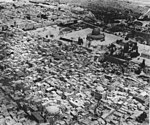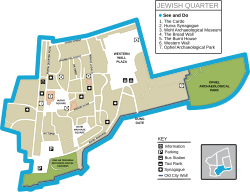
The Jewish Quarter (Hebrew: הרובע היהודי, HaRova HaYehudi or the Rova, Arabic: حارة اليهود, Harat al-Yehud) is one of the four traditional quarters of the Old City of Jerusalem. The 116,000 square meter area[1] lies in the southeastern sector of the walled city, and stretches from the Zion Gate in the south, along the Armenian Quarter on the west, up to the Street of the Chain in the north and extends to the Western Wall and the Temple Mount in the east.
The quarter is inhabited by around 2,000 residents and is home to numerous yeshivas and synagogues, most notably the Hurva Synagogue, destroyed numerous times and rededicated in 2010.
History
Antiquity


The quarter has had a rich history, with a nearly continual Jewish presence since the 8th century BCE.[citation needed] When, in CE 135, the Roman Emperor Hadrian built the city of Aelia Capitolina on the ruins of ancient Jerusalem, the Tenth Legion had their camp on the land that is now the Jewish Quarter.[2] At the start of the 20th century, the Jewish population of the quarter reached 19,000.[3]
Ottoman era
An Arabic inscription dating back to the 10th century from the Abbasid Caliphate was unearthed in the Jewish Quarter in 2010.[4]
The population of the quarter was not homogeneously Jewish, such a rule being neither desired by the Jewish inhabitants nor enforced by the Ottoman rulers. During the Ottoman era, most of the homes in the quarter were leased from Muslim property owners. This is one of the reasons for the growth of buildings west of the city in the last years of the Ottoman Empire since land outside the city was freehold (mulk) and easier to acquire.[5]
In 1857, the Batei Mahse housing complex was built by the Batei Mahse society, an organization of Dutch and German Jews.[6][7]
Jordanian era

In 1948 during the Arab-Israeli War, its population of about 2,000 Jews was besieged, and forced to leave en masse. Colonel Abdullah el Tell, local commander of the Jordanian Arab Legion, with whom Mordechai Weingarten negotiated the surrender terms, described the destruction of the Jewish Quarter, in his Memoirs (Cairo, 1959):
"... The operations of calculated destruction were set in motion.... I knew that the Jewish Quarter was densely populated with Jews who caused their fighters a good deal of interference and difficulty.... I embarked, therefore, on the shelling of the Quarter with mortars, creating harassment and destruction.... Only four days after our entry into Jerusalem the Jewish Quarter had become their graveyard. Death and destruction reigned over it.... As the dawn of Friday, May 28, 1948, was about to break, the Jewish Quarter emerged convulsed in a black cloud - a cloud of death and agony."
— Yosef Tekoah (Permanent Representative of Israel to the United Nations) quoting Abdullah el-Tal.[8]
The Jordanian commander is reported to have told his superiors: "For the first time in 1,000 years not a single Jew remains in the Jewish Quarter. Not a single building remains intact. This makes the Jews' return here impossible."[9] The Hurva Synagogue, originally built in 1701, was blown up by the Jordanian Arab Legion. During the nineteen years of Jordanian rule, a third of the Jewish Quarter's buildings were demolished.[10] All but one of the thirty-five Jewish houses of worship in the Old City were destroyed. The synagogues were razed or pillaged and stripped and their interiors used as hen-houses or stables.[8]
State of Israel

The Jewish Quarter remained under Jordanian occupation until the Six-Day War in June 1967. During the first week after taking the Quarter, the Mughrabi Quarter was razed to create a plaza at the foot of the Western Wall. In April 1968, the government expropriated 129 dunams (about 32 acres) of land which had made up the Quarter before 1948.[11] In 1969, the Jewish Quarter Development Company was established under the auspices of the Construction and Housing Ministry to rebuild the desolate Jewish Quarter.[12]
According to an article by Thomas Abowd in the Jerusalem Quarterly (Hawliyat al-Quds), the Arab population of the quarter reached approximately 1,000, most of whom were refugees[13] who had appropriated the vacated Jewish houses in 1949. Although many had originally fled the Quarter in 1967, they later returned after Levi Eshkol ordered that the Arab residents not be forcefully evacuated from the area. With Menachem Begin's rise to power in 1977, he decided that 25 Arab families be allowed to remain in the Jewish Quarter as a gesture of good will, while the rest of the families who had not fled during the Six-Day War were offered compensation in return for their evacuation, although most declined.[3] The quarter was rebuilt in keeping with the traditional standards of the dense urban fabric of the Old City. Residents of the quarter hold long-term leases from the Israel Lands Administration.[12] As of 2004 the quarter's population stood at 2,348[14] and many large educational institutions have taken up residence.
Before being rebuilt, the quarter was excavated under the supervision of Hebrew University archaeologist Nahman Avigad. The archaeological remains are on display in a series of museums two or three stories beneath the level of the current city as well as outdoor parks.
Landmarks

The most famous site of the Jewish Quarter is the Western Wall, a portion of the massive retaining wall built by Herod the Great in the 1st century BCE, expanding the Temple Mount that once contained the Temple of Jerusalem and today is home to the Dome of the Rock and Al-Aqsa Mosque. It consists of huge ashlar blocks that have been in place for two millennia. It is a major site for pilgrimage for Jewish people from all over the world, and is also a major tourist attraction for people of all faiths. Visitors insert handwritten prayers into the interstices between the stones. Numerous worshipers read Psalms in front of the wall and bar Mitzvahs are celebrated there.
See also
References
- ^ Kollek, Teddy (1977). "Afterword". In John Phillips (ed.). A Will to Survive - Israel: the Faces of the Terror 1948-the Faces of Hope Today. Dial Press/James Wade.
28+3⁄4 acres
- ^ "The Christian Heritage in the Holy Land" edited by Anthony O'Mahony with Goran Gunner and Hintlian. ISBN 1-900269-06-6. Pages 15 and 18. Jerome Murphy-O'Connor, "Pre-Constantinian Christian Jerusalem". At this time Hadrian expelled all Jews from the territory.
- ^ a b Hattis Rolef, Susan (2000). "The Jewish Quarter in Jerusalem". Architecture of Israel Quarterly. Retrieved 2007-12-26.
((cite web)): Italic or bold markup not allowed in:|publisher=(help) - ^ jpost.com staff (17 February 2010). "Jewish Quarter: Arabic inscription found". The Jerusalem Post.
- ^ Alexander Scholch, "Jerusalem in 19th Century (1831 - 1917 AD)" in "Jerusalem in History", Edited by K.J. Asali. 1989. ISBN 0-905906-70-5. Page 234. Quoting Muhammad Adib al-Amiri, "Al Quds al-'Arabiyya", Amman, 1971, page 12 (85% of Jewish Quarter was waqf owned), and 'Arif al-'Arif, "Al-Nakba", vol 2, Sidon and Beirut, page 490 (90%).
- ^ "The Jewish Quarter – BATEI MAHSE Square". Jewish-quarter.org.il. Retrieved 26 July 2012.
- ^ http://www.biu.ac.il/js/rennert/history_11.html
- ^ a b LETTER DATED 5 MARCH 1968 FROM THE PERMANENT REPRESENTATIVE OF ISRAEL TO THE UNITED NATIONS ADDRESSED TO THE SECRETARY-GENERAL
- ^ Shragai, Nadav (November 28, 2006). "Byzantine arch found at site of renovated Jerusalem synagogue". Ha'aretz. Retrieved 2007-07-25.
((cite web)): Italic or bold markup not allowed in:|publisher=(help) - ^ Fisk, Robert (September 30, 2000). "Bloodbath at the Dome of the Rock". The Independent. Archived from the original on 2008-05-06. Retrieved 2007-12-26.
((cite web)): Italic or bold markup not allowed in:|publisher=(help) - ^ "Christians in the Holy Land" Edited by Michael Prior and William Taylor. ISBN 0-905035-32-1. Page 104: Albert Aghazarian "The significance of Jerusalem to Christians". This writer states that "Jews did not own any more than 20% of this quarter" prior to 1948.
- ^ a b Zohar, Gil (November 1, 2007). "Trouble in the Jewish Quarter". Jerusalem Post. Retrieved 2008-02-26.
((cite web)): Italic or bold markup not allowed in:|publisher=(help) - ^ The Moroccan Quarter: A History of the Present, Thomas Abowd, Jerusalem Quarterly, nº7, 2000. Retrieved 2012-07-22.
- ^ shnaton C1404.xls
Further reading
- Prior, Michael P. (1999). Zionism and the state of Israel: a moral inquiry (Illustrated ed.). Routledge. ISBN 0-415-20462-3, 9780415204620.
((cite book)): Check|isbn=value: invalid character (help)
31°46′34″N 35°13′56″E / 31.77611°N 35.23222°E
| ||||||||||||||||||||||||||||||||||||||||
| Christianity |
| Areas, quarters
Gates
| ||||||||||||||||||||||||||||||||||||||
| Islam (Sunni Islamic Grand Mufti) |
| |||||||||||||||||||||||||||||||||||||||
| Judaism (Sephardic/Ashkenazi Chief Rabbis) |
| |||||||||||||||||||||||||||||||||||||||
| ||||||||||||||||||||||||||||||||||||||||
| Old Yishuv |
|---|
 |
| Key events |
| Key figures |
|
| Economy |
| Philanthropy |
| Communities |
| Synagogues |
| Related articles |
